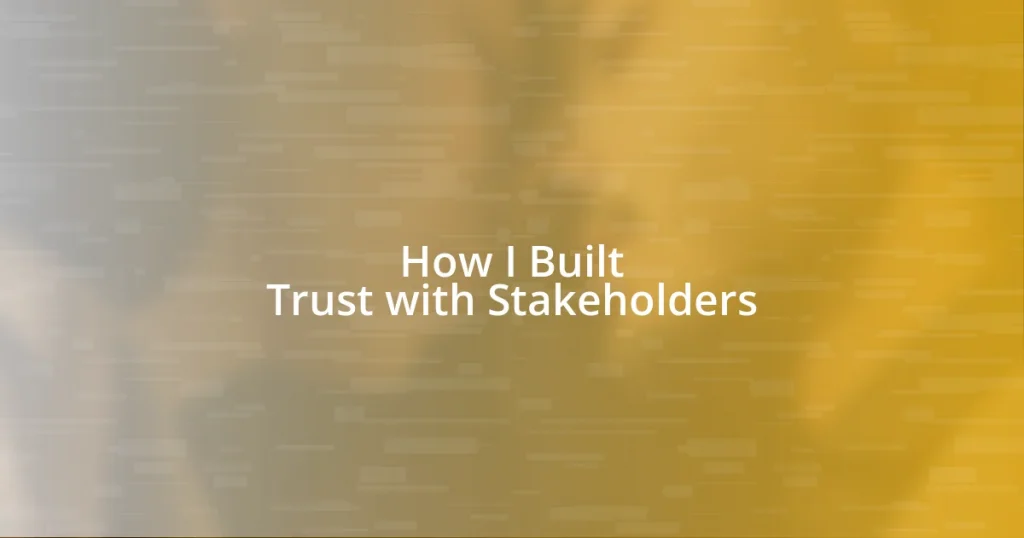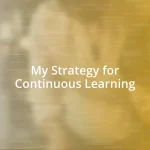Key takeaways:
- Understanding stakeholder expectations through open dialogue and active listening fosters partnership and clarity.
- Establishing clear communication channels, tailored to stakeholder preferences, enhances engagement and builds trust.
- Demonstrating reliability and consistency, alongside empathetic conflict resolution, strengthens relationships and fosters a collaborative environment.

Understanding stakeholder expectations
Understanding stakeholder expectations is pivotal. I remember a project where we overlooked some early insights from stakeholders, which led to misalignment down the road. It made me realize that assumptions about what stakeholders value can be misleading, so open dialogue is crucial.
As I navigated various projects, I found that stakeholders often desire transparency and communication. One time, after receiving feedback on my team’s lack of updates, I initiated regular briefings that transformed the relationship. I learned that when I proactively address their needs, it not only helps in managing expectations but also fosters a sense of partnership.
But how can we truly grasp what stakeholders expect? I’ve found that asking open-ended questions and actively listening brings forth invaluable insights. For example, by inviting stakeholders to share their thoughts rather than waiting for them to respond, I’ve uncovered priorities I hadn’t considered. This approach not only clarifies their vision but also deepens my understanding of their underlying motivations.

Establishing clear communication channels
Establishing clear communication channels is fundamental in developing trust with stakeholders. One time, during a critical project phase, I realized that our team relied heavily on emails for updates. However, many stakeholders felt overwhelmed by the volume and missed key points. I decided to implement weekly video calls, which created a space for real-time discussions. This shift not only increased engagement but also allowed for immediate feedback, reinforcing the relationship.
I’ve also learned the importance of tailoring communication methods to meet the diverse needs of stakeholders. For instance, while some prefer quick written updates, others appreciate in-depth reports or collaborative meetings. By understanding these preferences, I was able to facilitate more effective communication. In one case, a stakeholder mentioned feeling disconnected because they rarely engaged in the conversation. After acknowledging their need for more participative updates, we collaboratively designed a communication strategy that included their input, and the transformation in trust was palpable.
Adopting tools to support clear communication is another crucial aspect I found valuable. Using platforms like Slack or Trello allowed for organized discussions and transparency. It was empowering to witness how these tools enabled stakeholders to be part of the process, fostering a sense of ownership and commitment. It made me realize that investing in technology can break down barriers, ultimately enhancing our collaborative efforts.
| Communication Method | Benefits |
|---|---|
| Convenient for quick updates, but can overwhelm with volume | |
| Video Calls | Real-time engagement and immediate feedback |
| Written Reports | Allows for detailed insights but may lack interactivity |
| Collaboration Tools | Enhances transparency and stakeholder ownership |

Building relationships through transparency
Building relationships through transparency has always been a guiding principle in my approach to stakeholder interactions. I recall a situation in a challenging project where I made the decision to share not just the successes, but also the setbacks we faced. Opening up about our struggles was a bit daunting, but it created an unexpected bond. Stakeholders began to share their experiences too, and this exchange of vulnerabilities fostered an environment of trust. I learned that transparency isn’t just about sharing information; it’s about humanizing the process.
To truly nurture these relationships, I found a few strategies particularly effective:
- Regular Updates: Keeping stakeholders informed throughout the journey rather than just at milestones.
- Inclusive Decision-Making: Involving stakeholders in critical decisions to ensure they feel valued and heard.
- Honesty in Communication: Being upfront about challenges can lead to collaborative problem-solving rather than assigning blame.
Every time I embraced transparency, I noticed how it not only improved my rapport with stakeholders but also made our collaborative efforts more impactful. It paved the way for deeper connections that often translated into mutual respect and commitment.

Demonstrating reliability and consistency
Demonstrating reliability and consistency is a cornerstone in building trust with stakeholders. I remember one project where I committed to delivering weekly progress reports, even when everything seemed to be running smoothly. Surprisingly, when a snag arose, stakeholders appreciated my commitment to uphold consistency over perfection. It reinforced the message that, regardless of challenges, my objective was transparency and reliability.
Consistency also goes beyond just regular updates; it’s about maintaining the same level of quality and communication. For example, I once missed a deadline due to unforeseen circumstances. Instead of shying away from the situation, I immediately communicated the setback and provided an updated timeline. This honesty not only salvaged the trust we had but also showed stakeholders that I prioritized our relationship over merely meeting deadlines. I’ve learned that consistently showing up—even when things aren’t perfect—speaks volumes about one’s integrity.
Moreover, I’ve found that keeping promises, big or small, creates a ripple effect of trust. In another project, I promised to have a specific section of a report ready for review by a certain date. I ensured not just to deliver on time but also to provide thorough insights that exceeded expectations. The stakeholders noticed this attention to detail, and it motivated them to invest more deeply in our collaboration. Isn’t it fascinating how these consistent efforts can elevate relationships from transactional to truly collaborative?

Engaging stakeholders in decision-making
Engaging stakeholders in decision-making goes beyond simply inviting them to meetings. I recall a project where we formed a task force that included representatives from each key stakeholder group. This collaborative setup not only empowered stakeholders but also brought diverse perspectives to the table. I felt a noticeable shift in energy when they realized their insights were genuinely valued. It was that collective brainstorming that led to innovative solutions, highlighting the power of inclusivity.
I often ask myself: how can I make stakeholders feel more invested? One effective approach was implementing workshops where stakeholders could voice their thoughts on project direction. By facilitating these open dialogues, I was not just seeking their input; I was demonstrating that their opinions held weight in the decision-making process. The result? They took ownership of the decisions, and I noticed a stronger alignment with our shared goals. It’s fascinating how a simple shift in approach can foster such profound loyalty.
Lastly, keeping transparency intact throughout the decision-making process is crucial. Once, during a particularly complex initiative, I shared drafts of proposals with stakeholders before finalizing them. This not only clarified their concerns but also opened the door for invaluable feedback. I felt a deep sense of satisfaction when stakeholders thanked me for including them— it validated my belief that engagement builds commitment. Are we not all more willing to invest in something we’ve had a hand in shaping?

Addressing conflicts with empathy
Navigating conflicts requires a delicate touch, and I’ve learned that addressing these situations with empathy can make a world of difference. In one instance, I had a disagreement with a key stakeholder over project priorities. Instead of becoming defensive, I took a step back and actively listened to their concerns. This approach transformed the conversation; it felt less like a confrontation and more like a shared exploration. Have you ever noticed how simply acknowledging someone’s feelings can ease tension?
Another time, during a project review, a stakeholder expressed frustration about the direction we were taking. Instead of making excuses, I validated their feelings, saying, “I understand why you’re concerned; it’s important to me too.” That acknowledgment led to a more productive dialogue where we could collaboratively renegotiate our path forward. This experience reinforced my belief that empathy is not just a tool for conflict resolution; it’s a bridge that facilitates connection.
Ultimately, the goal is to create an environment where all voices feel heard. In my experience, tackling disagreements head-on but with compassion opens avenues for real understanding. I remember one challenging project where I openly admitted my mistakes during a conflict resolution meeting. The shift in atmosphere was palpable; stakeholders appreciated my honesty. Isn’t it striking how vulnerability can transform a fraught situation into an opportunity for growth?















